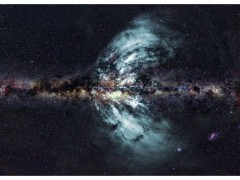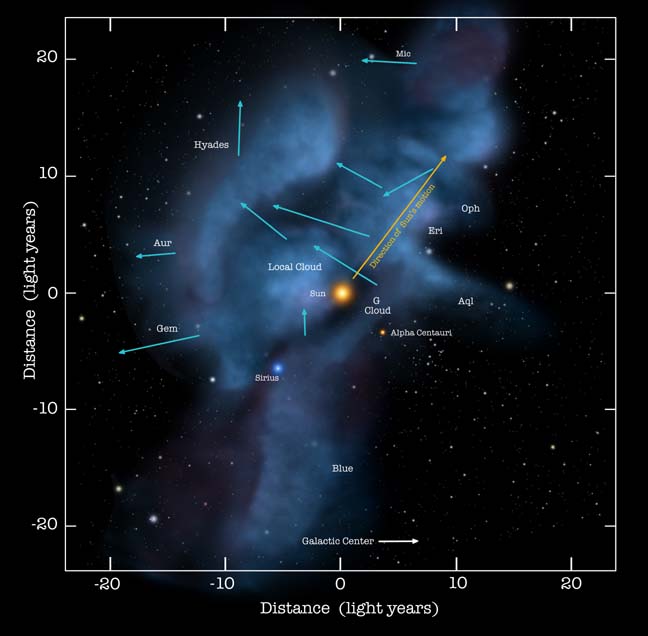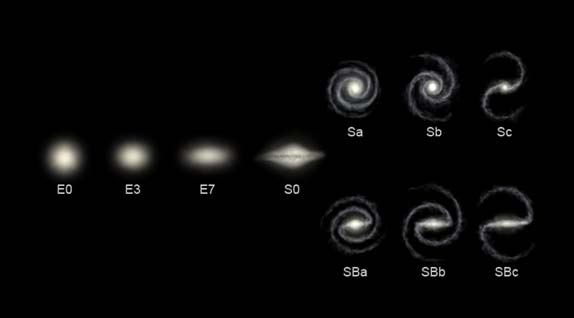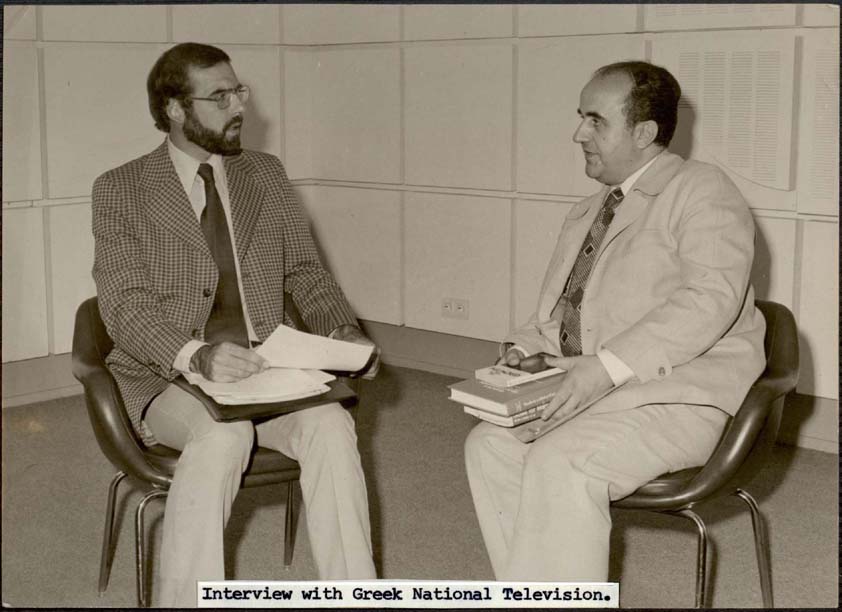Author Archives: Paul
Excerpt from Paul LaViolette's 1983 Ph.D. dissertation
"Galactic Explosions, Cosmic Dust Invasions, and Climatic Change"
From Chapter 3 "Modeling the Hypothesized 14,200 BP Superwave"
© 1983 Paul LaViolette
3.3.3 Geomagnetic Effects
As was mentioned in the previous subsection, solar flares would have been more energetic and would have occurred with greater frequency during a superwave event due to the accretion of nebular material by the Sun. Increased solar flare activity in turn would have produced substantial disturbances of the Earth's magnetic field, possibly even causing geomagnetic excursions and reversals. The means by which this could occur may be understood as follows.
Geomagnetic storms are known to occur several days after the appearance of a large solar flare, at a time when low and high energy particles from the flare are arriving in the Earth's vicinity. The first phase of the storm usually involves a sudden increase in the strength of the geomagnetic field, a phenomenon known as sudden commencement. This event typically lasts about 5 minutes and involves about a 0.1% increase in field strength. This is believed to be due to compression of the Earth's magnetosphere by solar-flare hydromagnetic blast wave consisting of an enhanced density of solar wind particles (Piddington, 1969, pp. 105, 118). The Earth's magnetopause would become thrust forward and compressed by the incident blast wave in much the same way that the heliopause sheath would become compressed by the arrival of a burst of Galactic cosmic ray electrons.
Sudden commencement is usually followed by a temporary decrease in geomagnetic field strength know as the main phase decrease. This period of decreased field strength, which may last for several days, is believed to be caused by solar flare cosmic rays trapped in spiral orbits around the Earth's magnetic field lines. These cosmic rays would form astorm-time radiation belt similar in nature to the Van Allen radiation belts which girdle our planet. Singer (1957) has suggested that such magnetically trapped particles would drift in an equatorial direction, westward for protons and eastward for electrons; see Figure 3.19. As a result, the motion of these particles would produce a ring current which in turn would generate a magnetic field opposed to the Earth's dipole field. The theory of this phenomenon has been more completely worked out by Dessler and Parker (1959) and others. Main phase decreases as large as 5 X 10-3 gauss (i.e., about 1% of the Earth's surface field intensity) are known to be produced by major solar flares, whose peak energy intensity can temporarily reach 100 times the intensity of the present cosmic ray background. It is believed that during such an event the Earth intercepts total cosmic ray energies in the range of 1022 - 1024 ergs, possibly supplied through the Earth's magnetotail plasma sheet (Piddington, 1969, pp. 180-181).
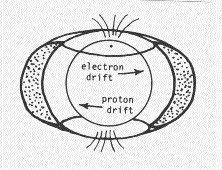
Figure 3.19. The inner Van Allen radiation belt. Arrows indicate the directions of particle drift which collectively constitute the ring current.
Suppose that during the proposed period of solar chromospheric activation a solar flare were to occur that was 100 times more intense than the most energetic solar flare observed during the past few decades, of a size typical of flares observed in T Tauri stars. Theoretical considerations show that the amplitude of the main phase decrease is proportional to the total particle energy in the radiation belt (Piddington, p. 180), and hence is roughly proportional to the initial magnitude of the solar flare. Thus ring current magnetic fields 100 times stronger than those thus far observed could conceivably occur, the applied opposed field reaching such a high intensity that it would essentially neutralize the Earth's dipole field.*
It is difficult to say what would happen when the intensity of the ring current field exceeded that of the geomagnetic field. Very likely the ring current field lines would close to form a doughnut-shaped field configuration having a symmetry axis that passed through the Earth's geomagnetic axis. The net field at the Earth's surface would then be reduced in intensity or even reversed in direction by the dominant ring current field. Cosmic rays would have difficulty escaping from their torroidal magnetic bottle since to do so they would have to slowly diffuse perpendicular to the direction of the field lines.
Such "field-reversed ion rings" have been created in the laboratory by using high-powered pulsed ion beams to inject large quantities of charged particles into an applied magnetic field (Golden et al., 1981). It is found that when the self-field generated by the ions exceeds the intensity of the applied magnetic field, a torroidal field-reversed configuration develops with a net reversed field in the interior of the particle ring. Field reversed ion rings are currently being researched as a means of confining plasmas for use in thermonuclear fusion reactors. However, they may also provide useful insights into the behavior of planetary fields during episodes of intense solar flare ion bombardment.
Whether the proposed ring current field was actually able to reverse the magnetic dynamo hypothesized to be present at the Earth's core would depend on a number of factors, such as the viscosity of the Earth's liquid interior and the momentum tied up in its motion. Under frictionless conditions a change in the dynamo's alignment would ultimately occur provided that sufficient time were allowed for the dynamo's inertia to be overcome.
The trajectory that the net magnetic field (ring current field) plus geomagnetic dynamo field) would follow is another question that must be considered. It is very likely that the local interplanetary field would play an important role. For example, the interplanetary magnetic field is known to reach peak strengths of 4 X 10-4 gauss during solar flare events (Brandt, 1970, p. 131). During mega-solar-flares associated with a solar T Tauri phase, temporary field strengths in the range of 10-3 - 10-2 gauss could be expected. The interplanetary field is observed to be oriented in the plane of the ecliptic in a spiral pattern. Consequently, if this ambient field were to cause a reorientation of the net field pattern, the virtual geomagnetic pole would probably drift to within ±23° of the Earth's equator. Such an orientation appears to have temporarily occurred around 12,400 varve years BP [14,200 calendar years BP]; see Chapter 7 (Subsection 7.2.3).
As the intensity of the storm-time radiation belts decreased and the ring current field subsided, the geomagnetic poles would be free to drift away from their metastable equatorial position, taking either their former orientation, or a reversed polarity position. If the reversed position were attained, then the geomagnetic field would have to wait for another solar-cosmic event for an opportunity to reverse once again and attain normal polarity.
Uffen (1963) has proposed that the Earth's core dynamo is inherently unstable and subject to spontaneous reversals. Thus he seeks a purely terrestrial explanation for this phenomenon. However, there are those who point out that the Earth's core dynamo would not be able to self-reverse, but would require the assistance of a sudden external disturbance (Bucha, 1973; after Bullard, 1971). I would add that since the hypothesized dynamo mechanism is not well understood, attempts to attribute flips to instabilities in this not-well-understood mechanism should be regarded as being speculative. Moreover, such a mechanism alone would not be able to account for the observation that geomagnetic flips coincide with extinction episodes; see Chapter 11 (Subsection 11.2.1).
The theory of radiation belt currents, on the other hand, is well developed (Singer, 1957; Dessler and Parker, 1959) and the proposal that cosmic ray outbursts (e.g., from the Sun) cause disturbances to the Earth's magnetic field is well established on observational grounds. My proposal that large solar flare outbursts associated with the passage of a superwave would cause disturbances to the Earth's magnetic field simply involves a quantitative scaling up of a phenomenon that is already well understood. The possibility that a ring current magnetic field could be responsible for causing geomagnetic polarity reversals though, to my knowledge, has not been previously suggested. Consequently, this may be regarded as an original contribution of this study.
It is also possible that a passing energetic superwave, a transit of the heliopause sheath, or a nearby supernova explosion could also supply sufficiently large quantities of cosmic rays to the radiation belts to cause a field reversal. While these may be reasonable mechanisms for explaining many of the reversals in the sedimentary record, they must be ruled out as causes for the Late Pleistocene reversals since they would have produced an inordinately large increase in terrestrial C-14 levels, which is not observed.
___________________
* Today it is known that solar flare cosmic rays are expelled in the form of solar proton events and "coronal mass ejections" and that a solar storm occurs when one such ejections happen to contact the Earth. Consequently, in this geomagnetism theory I was essentially proposing that geomagnetic flips are induced by major solar proton events or coronal-mass-ejections contacting the Earth (see Earth Under Fire). Although the notion of solar coronal mass ejections was not current at that time, in Chapter 4 of my dissertation I presented this concept as a way of accounting for the glazing of lunar rocks. PAL 1/29/99
References:
Brandt, J. C. Introduction to the Solar Wind. San Francisco: Freeman & Co., 1970, p. 131.
Bucha, V. "The continuous pattern of variation of the geomagnetic field in the Quaternary and their causes." Studia Geophysica et Geodaetica. 17 (1973): 218.
Bullard, E. C. "Dynamo theory." In World Magnetic Survey, edited by J. Zmuda. IAGA Bulletin No. 28 (1971): 112.
Dessler, A. J., and Parker, E. N. "Hydromagnetic theory of geomagnetic storms." Journal of Geophysical Research 64 (1959): 2239.
Golden, J., Kapetanakos, C. A., Pasour, J. A., and Mahaffey, R. A. "The generation and application of intense pulsed ion beams."American Scientist 69 (1981): 173.
Piddington, J. H. Cosmic Electrodynamics. New York: John Wiley & Sons, 1969.
Singer, S. F. Transactions of the American Geophysical Union 38 (1957):175.
Uffen, R. J. "Influence of the Earth's core on the origin and evolution of life." Nature 198 (1963): 143 - 144.
High-velocity outflows from the GC, or a misinterpretation?
A group of astronomers has recently reported radio telescope data which they claim is evidence of an immense high velocity outflow or “geyser” of magnetized plasma from the center of the Milky Way whose origin they attribute to starburst activity in the Galaxy’s central region. They report their results in the Jan. 2 issue of Nature magazine. Also see the following news articles:
https://www.sciencedaily.com/releases/2013/01/130102140349.htm
https://www.csiro.au/Portals/Media/Our-Galaxys-geysers-are-towers-of-power.aspx
I have received several emails from people inquiring if this may be evidence of a past Galactic core outburst similar to that discussed in a previous posting on the Fermi bubbles. I believe that this is not evidence of a Galactic core outflow. Neither do I believe that it is evidence of a geyser-like starburst outflow from the center of the Milky Way as the authors of the Nature paper claim. In fact, believe that this emission has nothing to do with the Galactic center.
For more on this story visit the Starburst Superwave Forum
Will a superwave arrive around July 2013 and cause a widespread catastrophe?

Artist's depiction of the G2 cloud being dispersed and swallowed during its close approach to Sagittarius A*
For a decade now astronomers have been tracking the progress of a dense gas cloud called G2 which now is rapidly approaching the Galactic center on a very eccentric elliptical orbit (eccentricity ~ 0.95) and is estimated to reach pericenter (the point of closest approach) around the beginning of July 2013. Tidal forces have already been observed to stretch the cloud and these forces will become increasingly strong over the next 9 months as the cloud approaches orbit pericenter at which point it is thought that they will be strong enough to completely rip the cloud apart. At this point the dispersed cloud is expected to be gravitationally drawn into the Galactic core with the consequent release of a large amount of energy in the form of cosmic rays and gamma ray emission.
I have been asked by several people whether the cloud’s consumption on this 2013 date might produce a Galactic superwave which would be reaching our solar system on that same date (due to the ability of the cosmic rays to travel straight toward us at close to the speed of light) and produce a major solar system cataclysm; e.g. see the forum comment by psychiceyes. Indeed, due to the ending of the Mayan calendar cycle on December 21, 2012, there are many who expect an end of world scenario or consciousness transition event. In fact, some groups have built shelters in the heart of Australia and South Africa with this expectation in mind.
To read more on this go to the Superwave Forum.
Release of Project Montgolfier Report on T. T. Brown's 1955 - 1956 Electrogravitic Experiments
In 1955 and 1956 Townsend Brown made two trips to Paris where he conducted tests of his electrokinetic apparatus and electrogravitic vacuum chamber tests in collaboration with the French aeronautical company Société National de Construction Aeronautiques du Sud Ouest (S.N.C.A.S.O.). He was invited there by Jacques Cornillon, the company’s U.S. technical representative. Details of the Project Montgolfier experiments remained a closely guarded secret for many years until Jacques Cornillon courageously decided to make them public prior to his death in July 2008.
An overview of the Project Montgolfier material and links for downloading the documents may be found posted on the Starburst Foundation Electrogravitics Forum at: https://starburstfound.org/electrograviticsblog/?p=49.
Solar Storm Warning!!
May 9, 2012 Warning
NASA today warned that the Sun has erupted with a very large sunspot complex that has produced an M1.4 solar flare and launched a barrage of solar cosmic ray particles and a coronal mass ejection that are headed our way.
https://www.msnbc.msn.com/id/47339655/ns/technology_and_science-space/#.T6rLiUZ_Xm8
https://www.cosmosmagazine.com/news/5205/biggest-solar-storm-2005-pummels-earth
Are we in Danger from a Local Interstellar Cloud Incursion?
The solar system is currently embedded in the Local Interstellar Cloud, or Local Fluff as it is sometimes called, a gas cloud about 30 light years wide and travelling past us at 29 km per second. At this speed we should be going through it for the next 300,000 years. It has been suggested that this cloud may contain cloudlets having gas densities hundreds of times higher than the Local Interstellar Cloud average. How far away they may lie from the solar system or when they will impact us remains open to speculation. But, one might ask how likely it is that the solar system’s movement through such a high density region will affect the Sun and Earth, whether it will impact us in a way similar to how a superwave has done in the past? First, we may surmise that we are not dealing with any kind of immediate threat. If such a cloudlet were as close as 1 to 2 light years from us, at this speed of passage it would take 10,000 to 20,000 years before it reached us. We should, then, be more concerned with the impending arrival of a galactic superwave which with a very great likelihood could arrive in the next few centuries.
However, suppose we assume for the moment that there is an impending threat from such a cloudlet incursion. Would the solar and climatic effects be like that of a superwave? Well we can do some calculations to find out. Given that the Local Fluff has a density of ~0.1 hydrogen atoms/cm3. The hypothesized cloudlet, which could have a density hundreds of times greater, would then have a density of say around 20 to 50 hydrogen atoms per cubic centimeter. This would equal a cloud density of around 3 to 8 X 10-23grams/cm3. An interstellar cloud incursion of this sort would have a significant climatic effect and a significant solar effect. But the most dangerous phase would likely last for several years, rather than for centuries or millennia as is often the case for the effects from a superwave.
More on this is posted on the Starburst Superwave Forum:
Resurrection of the Hubble-Jeans Galaxy Formation Theory
A review of the most recent data on galaxy evolution shows that the subquantum kinetics continuous creation theory of galaxy formation is correct. That galaxies progressively grow in size and mass, proceeding from dwarf elliptical to S0 to mature spiral and finally to giant elliptical. The data also call for the reinstatement of the galaxy evolution theory which Edwin Hubble and Sir James Jeans proposed in the early 20th century. It indicates that Hubble's "tuning fork" diagram of galaxy evolution was largely correct with one exception. The elliptical galaxies on the left should be considered dwarf spheroidals and dwarf ellipticals while the giant elliptical category should be placed in a new branch to the right of the spirals, with both spiral category branches evolving into the giant elliptical category.
Hubble's classification scheme is used even today. Even so, astronomer's today have largely rejected Hubble's evolution theory in favor of galaxy merger theories. In the ebook fourth edition of Subquantum Kinetics, Paul LaViolette discusses recent evidence which supports the subquantum kinetics galaxy evolution model, as well as the Hubble-Jeans evolution model and shows that the current galaxy merger theory is seriously problematic, as is the big bang theory.
News reports on solar energy
Solar Energy Findings
• Oregon Journal, June 16, 1977
• Schenectady Gazette, July 23, 1977
• Solar Energy Intelligence Report, June 20, 1977
• Ekonomikos (Greek newspaper), October 13, 1977
• Eleftherotypia (Greek newspaper), September 21, 1977
• Eleftheros Kosmos (Greek newspaper), October 2, 1977
• Kathimerini (Greek newspaper), October 25, 1977
• Ta Nea (Greek newspaper), September 27, 1977
• Politika Themata (Greek magazine), September 17, 1977
• Lecture at the Evgenidion Planetarium, Athens, Sept. 14, 1977
P. LaViolette being Interviewed by ERT Television, Athens, Sept., 1977
Evidence for a solar cause to the Pleistocene mass extinction
For Immediate Release (Science)
June 3, 2011
The Starburst Foundation
plaviolette@starburstfound.org
Evidence that the Pleistocene mass extinction
may have had a solar cause
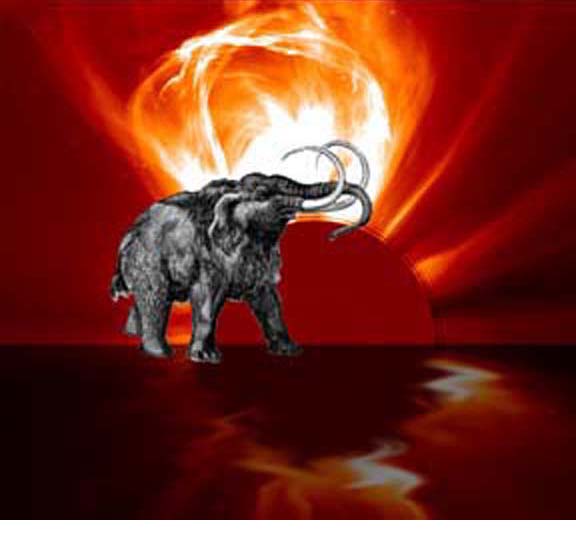 Close to the end of the last ice age there was a sudden disappearance of many mammalian species which some paleontologists say was the most severe since the disappearance of the dinosaurs 65 million years ago. In North America 95 percent of the megafauna became extinct, these being predominantly mammals having body weights greater than 25 to 50 kilograms. But even small animals were affected, as in the disappearance of 10 genera of birds. Although North America was most affected, it had a severe impact also in Europe, Siberia, and South America.
Close to the end of the last ice age there was a sudden disappearance of many mammalian species which some paleontologists say was the most severe since the disappearance of the dinosaurs 65 million years ago. In North America 95 percent of the megafauna became extinct, these being predominantly mammals having body weights greater than 25 to 50 kilograms. But even small animals were affected, as in the disappearance of 10 genera of birds. Although North America was most affected, it had a severe impact also in Europe, Siberia, and South America.
The cause of the extinction has long remained a mystery. Theories that have been put forth have ranged from overkill by North American paleolithic hunters to the impact of a large comet or swarm of meteors. But all have been shown to have serious flaws. Now, Starburst Foundation researcher Dr. Paul LaViolette has found evidence that this mysterious die-off may have had a solar flare cause. In his paper published this week in the journal Radiocarbon, LaViolette concludes that a super sized solar proton event (SPE) impacted the earth about 12,900 years ago (12,837± 10 calendar years BP).* He notes that this date roughly coincides with that of the Rancholabrean termination, a time boundary beyond which the numbers of extinct megafaunal remains are found to sharply decline. Solar proton events, blasts of energetic solar cosmic ray particles that are shot out with the eruption of a solar flare, can arrive with little advance notice, traversing the 93 million mile distance from the Sun to the Earth in a matter of hours. They are usually followed some days later by a slower moving solar wind plasma shock called a coronal mass ejection. They have been observed to occur from time to time in past decades, but none in modern times have been strong enough to pose a serious ground-level radiation hazard.
* LaViolette, P. A., Evidence for a solar flare cause of the Pleistocene mass extinction, Radiocarbon 53(2), 2011, pp. 303-323.
Free download of a preprint of this paper: starburstfound.org/downloads/superwave/SPE.html
Experiment to test whether inertial mass can be artificially altered
Posted May 26, 2011
by Paul LaViolette
The subquantum kinetics physics theory predicts that the inertial mass of a body can be changed by altering either its electric or gravitational potential. High negative voltage potentials or positive G potentials (gravity hills) are predicted to reduce inertial mass, while high positive voltage potentials or negative G potentials (gravity wells) are predicted to increase inertial mass. At present, a considerable amount of theoretical work needs to be done to determine how large a voltage potential would be needed to produce the predicted effect. Nevertheless, even without a specific quantitative prediction, we felt that if an effect was seen, this would provide strong support for the subquantum kinetics paradigm since such mass altering effects are not predicted by standard physics theory. For some time we have been interested to search for such an effect; for example, see Project No. 16 of the Starburst Projects List.
On Saturday May 21, 2011 Starburst Foundation researcher Paul LaViolette conducted this experiment in the New York laboratory of Alexi Guy Obolensky, with Mr. Obolensky and his assistant John being directly involved in the measurement process. Two mechanical pocket watches were used to check for any sign of inertial mass variation. These pocket watches use a torsion pendulum for their timing, that is, a wheel having a mass at its rim and a spring applying torque. Any change in the mass of the wheel would reflect as a change in the ticking rate of the watch. Under normal conditions, the two watches were found to deviate in their timing by less than 0.1 seconds over a 15 minute period, hence by less than one part in 104. One watch was placed within a metallic sphere which was charged to -200 kilovolts for a period of 15 minutes. The other watch was kept some distance from the sphere and was used as a time reference. The watches were started simultaneously, the one was placed within its sphere, the sphere energized and after 15 minutes discharged once again, and then the two watches were finally brought together and simultaneously stopped.
The outcome of the experiment was that no time difference was seen between the two watches. Hence if any inertial mass change was in fact induced during the 15 minute test period, it would have had to be less than one part in 104. The experiment was run once with the target watch grounded to its metal sphere by a wire inside the sphere and once with the watch electrically isolated from its enclosing sphere. Also a third trial was performed in which the sphere was repeatedly charged and then completely discharged 15 times per second during the 15 minute test period. Again, even in this pulsed mode, no evidence of a change of inertial mass.
Erwin Saxl in 1964 claimed to have observed that the period of a torsion pendulum had changed by 0.4 to 0.7% when energized to +5000 V or -5000 V. Liu et al. (1998) later checked Saxl's results energizing a torsion pendulum to ±2000 volts. They saw no period change from the application of the voltage potential indicating that if there had been any change of inertial mass it would have had to be less than one part per billion. Our findings are consistent with those of Liu et al. Although our time measurement resolution was far less, we did extend this measurement to voltages 100 fold greater than used by Liu et al.
Mikhailov (1999) measured the oscillation period of an electron plasma confined within an electrically charged sphere and found evidence that the electron's inertial mass had varied by ±0.3% when the sphere was charged respectively to ±3000 volts. LaViolette had reasoned that if this mass change effect was due to an electrogravitic inertial mass change effect of the sort predicted by subquantum kinetics, then a similar inertial mass change should be observed for neutral matter as well. Hence the incentive to conduct the stop watch experiment. The null result of this watch experiment suggests that the phenomenon observed by Mikhailov may be due to another effect. For example, Assis (1993) attributes the electron inertial mass variation observed by Mikhailov to an effect predicted by Weber's theory of electromagnetism.
E. Saxl Nature 203 (1964):136-139.
Y. Liu, et al. Physics Letters A 244 (1998):1-3.
V. F. Mikhailov Ann. Fonde. Louis de Broglie 24 (1999):161-169.
A. K. T. Assis J. Phys. Soc. Japan 62 (1993):1418-1422.

